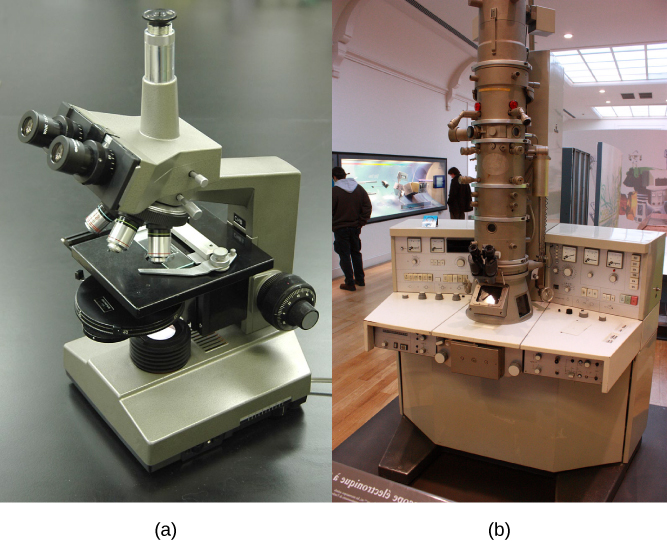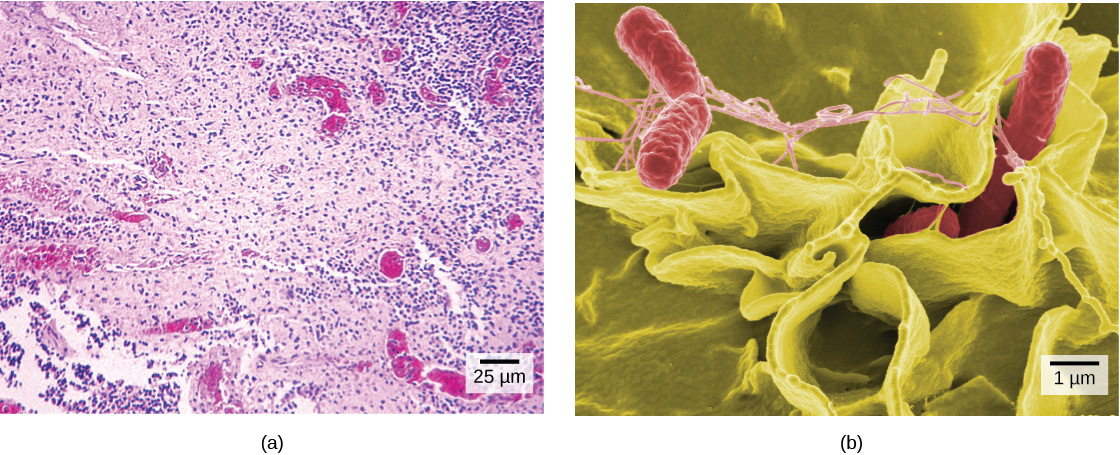15 Studying Cells
Learning Objectives
By the end of this section, you will be able to do the following:
- Describe the role of cells in organisms
- Compare and contrast light microscopy and electron microscopy
- Summarize cell theory
A cell is the smallest unit of a living thing. Whether comprised of one cell (like bacteria) or many cells (like a human), we call it an organism. Thus, cells are the basic building blocks of all organisms.
Several cells of one kind that interconnect with each other and perform a shared function form tissues. These tissues combine to form an organ (your stomach, heart, or brain), and several organs comprise an organ system (such as the digestive system, circulatory system, or nervous system). Several systems that function together form an organism (like a human being). Here, we will examine the structure and function of cells.
There are many types of cells, which scientists group into one of two broad categories: prokaryotic and eukaryotic. For example, we classify both animal and plant cells as eukaryotic cells; whereas, we classify bacterial cells as prokaryotic. Before discussing the criteria for determining whether a cell is prokaryotic or eukaryotic, we will first examine how biologists study cells.
Microscopy
Cells vary in size. With few exceptions, we cannot see individual cells with the naked eye, so scientists use microscopes (micro- = “small”; -scope = “to look at”) to study them. A microscope is an instrument that magnifies an object. We photograph most cells with a microscope, so we can call these images micrographs.
The optics of a microscope’s lenses change the image orientation that the user sees. A specimen that is right-side up and facing right on the microscope slide will appear upside-down and facing left when one views through a microscope, and vice versa. Similarly, if one moves the slide left while looking through the microscope, it will appear to move right, and if one moves it down, it will seem to move up. This occurs because microscopes use two sets of lenses to magnify the image. Because of the manner by which light travels through the lenses, this two lens system produces an inverted image (binocular, or dissecting microscopes, work in a similar manner, but include an additional magnification system that makes the final image appear to be upright).
Light Microscopes
To give you a sense of cell size, a typical human red blood cell is about eight millionths of a meter or eight micrometers (abbreviated as eight μm) in diameter. A pin head is about two thousandths of a meter (two mm) in diameter. That means about 250 red blood cells could fit on a pinhead.
Most student microscopes are light microscopes ((Figure)a). Visible light passes and bends through the lens system to enable the user to see the specimen. Light microscopes are advantageous for viewing living organisms, but since individual cells are generally transparent, their components are not distinguishable unless they are colored with special stains. Staining, however, usually kills the cells.
Light microscopes that undergraduates commonly use in the laboratory magnify up to approximately 400 times. Two parameters that are important in microscopy are magnification and resolving power. Magnification is the process of enlarging an object in appearance. Resolving power is the microscope’s ability to distinguish two adjacent structures as separate: the higher the resolution, the better the image’s clarity and detail. When one uses oil immersion lenses to study small objects, magnification usually increases to 1,000 times. In order to gain a better understanding of cellular structure and function, scientists typically use electron microscopes.

Electron Microscopes
In contrast to light microscopes, electron microscopes ((Figure)b) use a beam of electrons instead of a beam of light. Not only does this allow for higher magnification and, thus, more detail ((Figure)), it also provides higher resolving power. The method to prepare the specimen for viewing with an electron microscope kills the specimen. Electrons have short wavelengths (shorter than photons) that move best in a vacuum, so we cannot view living cells with an electron microscope.
In a scanning electron microscope, a beam of electrons moves back and forth across a cell’s surface, creating details of cell surface characteristics. In a transmission electron microscope, the electron beam penetrates the cell and provides details of a cell’s internal structures. As you might imagine, electron microscopes are significantly more bulky and expensive than light microscopes.

For another perspective on cell size, try the HowBig interactive at this site.
Cell Theory
The microscopes we use today are far more complex than those that Dutch shopkeeper Antony van Leeuwenhoek, used in the 1600s. Skilled in crafting lenses, van Leeuwenhoek observed the movements of single-celled organisms, which he collectively termed “animalcules.”
In the 1665 publication Micrographia, experimental scientist Robert Hooke coined the term “cell” for the box-like structures he observed when viewing cork tissue through a lens. In the 1670s, van Leeuwenhoek discovered bacteria and protozoa. Later advances in lenses, microscope construction, and staining techniques enabled other scientists to see some components inside cells.
By the late 1830s, botanist Matthias Schleiden and zoologist Theodor Schwann were studying tissues and proposed the unified cell theory, which states that one or more cells comprise all living things, the cell is the basic unit of life, and new cells arise from existing cells. Rudolf Virchow later made important contributions to this theory.
CytotechnologistHave you ever heard of a medical test called a Pap smear ((Figure))? In this test, a doctor takes a small sample of cells from the patient’s uterine cervix and sends it to a medical lab where a cytotechnologist stains the cells and examines them for any changes that could indicate cervical cancer or a microbial infection.
Cytotechnologists (cyto- = “cell”) are professionals who study cells via microscopic examinations and other laboratory tests. They are trained to determine which cellular changes are within normal limits and which are abnormal. Their focus is not limited to cervical cells. They study cellular specimens that come from all organs. When they notice abnormalities, they consult a pathologist, a medical doctor who interprets and diagnoses changes that disease in body tissue and fluids cause.
Cytotechnologists play a vital role in saving people’s lives. When doctors discover abnormalities early, a patient’s treatment can begin sooner, which usually increases the chances of a successful outcome.

Section Summary
A cell is the smallest unit of life. Most cells are so tiny that we cannot see them with the naked eye. Therefore, scientists use microscopes to study cells. Electron microscopes provide higher magnification, higher resolution, and more detail than light microscopes. The unified cell theory states that one or more cells comprise all organisms, the cell is the basic unit of life, and new cells arise from existing cells.
Review Questions
When viewing a specimen through a light microscope, scientists use ________ to distinguish the individual components of cells.
- a beam of electrons
- radioactive isotopes
- special stains
- high temperatures
C
The ________ is the basic unit of life.
- organism
- cell
- tissue
- organ
B
Critical Thinking Questions
In your everyday life, you have probably noticed that certain instruments are ideal for certain situations. For example, you would use a spoon rather than a fork to eat soup because a spoon is shaped for scooping, while soup would slip between the tines of a fork. The use of ideal instruments also applies in science. In what situation(s) would the use of a light microscope be ideal, and why?
A light microscope would be ideal when viewing a small living organism, especially when the cell has been stained to reveal details.
In what situation(s) would the use of a scanning electron microscope be ideal, and why?
A scanning electron microscope would be ideal when you want to view the minute details of a cell’s surface, because its beam of electrons moves back and forth over the surface to convey the image.
In what situation(s) would a transmission electron microscope be ideal, and why?
A transmission electron microscope would be ideal for viewing the cell’s internal structures, because many of the internal structures have membranes that are not visible by the light microscope.
What are the advantages and disadvantages of each of these types of microscopes?
The advantages of light microscopes are that they are easily obtained, and the light beam does not kill the cells. However, typical light microscopes are somewhat limited in the amount of detail they can reveal. Electron microscopes are ideal because you can view intricate details, but they are bulky and costly, and preparation for the microscopic examination kills the specimen.
Explain how the formation of an adult human follows the cell theory.
The cell theory states:
- All living things are made of cells.;
- Cells are the most basic unit of life.;
- New cells arise from existing cells.
All humans are multicellular organisms whose smallest building blocks are cells. Adult humans begin with the fusion of a male gamete cell with a female gamete cell to form a fertilized egg (single cell). That cell then divides into two cells, which each divides into two more cells, and so forth until all the cells of a human embryo are made. As the embryo passes through all the developmental stages to make an adult human, the cells that are added arise from division of existing cells.
Glossary
- cell theory
- see unified cell theory
- electron microscope
- an instrument that magnifies an object using an electron beam that passes and bends through a lens system to visualize a specimen
- light microscope
- an instrument that magnifies an object using a beam of visible light that passes and bends through a lens system to visualize a specimen
- microscope
- an instrument that magnifies an object
- unified cell theory
- a biological concept that states that one or more cells comprise all organisms; the cell is the basic unit of life; and new cells arise from existing cells

